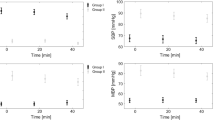Abstract
Respiratory and circulatory conditions that could have an influence on measurements of pallor of the papilla were evaluated with our photopapillometer in a controlled study on canines. The brightness of the papilla rim and the width of the arterioles emerging from the optic nerve head were measured in six anesthetized dogs under normal, hypertensive, and hypotensive circulatory conditions, as well as under various respiratory manipulations, and the parameters were compared for statistical correlation. Both brightness and vessel width remained constant for a wide range of arterial pressures when the rest of the experimental conditions were kept stable at naturally occurring levels. If respiration and circulation were brought to extreme levels, however, there was a statistical tendency for the brightness of the papilla to be dependent on arterial and pulmonary arterial blood pressure. The importance of these findings is discussed with regard to their influence on objective measurements of fundus brightness.
Similar content being viewed by others
References
Bracher D, Dozzi M, Lotmar W (1979) Measurement of vessel width on fundus photographs. Graefe's Arch Clin Exp Ophthalmol 211: 35–48
Daum K, Fry G (1982) Pupillary micro-movements apparently related to pulse frequency. Vis Res 22: 173–177
Guyton A (1976) Textbook of medical physiology. Saunders, Philadelphia, pp 230–231
Hendrickson P, Robert Y (1984) Direkte Messung der Papillenhelligkeit. Klin Monatsbl Augenheilkd 184: 357–358
Hendrickson P, Robert Y, Stöckli H-P (1984) Principles of photometry of the papilla. Arch Ophthalmol 102: 1704–1707
Nissen O (1981) The effect of intraocular pressure and glaucomatous damage on intraocular pressure pulse amplitudes. Acta Ophthalmol 59: 225–230
Oggel K, Sommer G, Neuhann T, Hinz J (1982) Verä nderungen des Augeninnendruckes bei intrathorakaler Druckerhöhung in Abhängigkeit von der Kö rperposition und der Achsenlänge des Augapfels. Graefe's Arch Clin Exp Ophthalmol 218: 51–54
Robert Y (1983) Messung der optischen Dichte des Sehnervenkopfes — Schwankungen der Papillenhelligkeit. Klin Monatsbl Augenheilkd 182: 3968398
Rubin L (1974) Atlas of veterinary ophthalmology. Lea & Febiger, Philadelphia, pp 70–73
Smith A, Wollman H (1972) Cerebral blood flow and metabolism: effect of anesthetic drugs and techniques. Anesthesiology 36: 378–400
Sossi N, Anderson D (1983) Effect of elevated IOP on blood flow. Arch Ophthalmol 101: 98–101
Tachibana H, Gotoh F, Ishikawa Y (1982) Retinal vascular autoregulation in normal subjects. Stroke 13: 149–155
Weinstein J, Funsch D, Page R, Brennan R (1982) Optic nerve blood flow and its regulation. Invest Ophthalmol Vis Sci 23: 640–645
Author information
Authors and Affiliations
Rights and permissions
About this article
Cite this article
Robert, Y., Hendrickson, P., Bläss, J. et al. Respiratory and circulatory influence on photopapillometry. Graefe's Arch Clin Exp Ophthalmol 224, 96–100 (1986). https://doi.org/10.1007/BF02144146
Received:
Accepted:
Issue Date:
DOI: https://doi.org/10.1007/BF02144146




